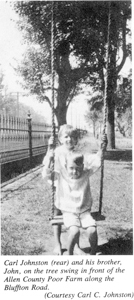THE POOR FARM SCHOOL

My Aunt Gladys says that the Main Building housed about 180 people. Eight patients worked in the kitchen in addition to the cook. The two dining rooms had wood doors made with narrow boards that were white because of the strong cleaners that were used rather than hard scrubbing. The right wing housed the women and most of their main floor was a sitting room. It was in this room that they had the Christmas tree which usually reached the ceiling. Holders that clamped to the limbs held candles, which were lighted on Christmas Eve. There were gifts for everyone. Maybe an orange, hard candy and some personal items such as a comb, pipe or talcum powder. Some things probably came from the churches.
Any religious group that requested it, was offered a Sunday to give its message and sing their songs, and the service was always held in the women’s sitting room. We will never know if they saved any souls, but a religious service certainly broke the boredom and was meaningful to some. We sometimes attended, and I will never forget the preachers who yelled at these older, poor and sometimes ill people, “You are sinners!” with threats and predictions of flaming hell. It was information that this captive audience did not need.
Our family usually attended the Wayne Street Methodist Church, but sometimes it was difficult to get there. If we went to Fort Wayne at night, my father would roll up a newspaper and light the end and wave the lighted torch to get the interurban to stop for us.
The men were housed in the left wing with about the same amount of sitting room. Smoking was not allowed up in the building but the men had a card and smoking room on the lower level. They also sat outside more than did the women.
There were rooms on the first floor for patients who were confined to bed. But all patients who were able to care for themselves slept in the dormitory on the second floor of each wing. They were always clean and white and well cared for. A chart was kept in this area to assure that each patient bathed regularly. Some people did not want to take a bath, which I think was required once a week. Little wonder perhaps. The water was hard and at that time the only soap available was a big white cake of Hard Water Castile. Some surely must have suffered with dry skin and itching with nothing to ease it, although rose water and glycerine was commonly used. In my lifetime we passed through a time when a weekly bath was considered acceptable to a time when we looked askance at those who did not profess the daily bath habit.
Some patients were bedfast and seriously ill. The nurse was Mrs. Branstrator; they called her Mrs. Bee. Doctor William Enslen came to the Infirmary regularly. One lady, I recall, had a huge belly, obviously a tumor. A couple of ladies had large goiters. Some had cancer. One man who had been there for ten or twelve years, had a cancer that was eating away his face. Grandma was gentle, and she was the one who brushed his open face with Kloria. He said she was an angel of mercy. I have been unable to learn what Kloria might have been. It was a clear liquid. Grandma did not know at that time that one side of Grandpa’s face would be eaten away by the same illness before he died. Another treatment they relied on was Unguentine salve. After I caught my fingers in the gears driving a horseradish grinder, the nurse soaked away the bloody bandages in water that had turned blue or green after some bichloride or mercury tablets were dissolved in it. I understand it is no longer used as a germicide or disinfectant because of its poisonous nature.
Many of the patients talked to themselves, or their lips moved, or they had ailments that caused them to move, be nervous or fidgety. But most were like all the rest of us except they were unfortunate and unable to care for themselves.
Sam Hart was a bearded man whose right leg was amputated above the knee. When we asked him how it happened, he said a steamboat ran over it. There were a number of men who would come to the Infirmary voluntarily in the fall and then leave in the spring. But some patients were not desirable. One man was brought out by the police. He was filthy and buggy. He never entered the building. Instead they took him out to the barn, scrubbed him with a hose, cut off his matted hair, put clean clothes on him and put him on the interurban with money for a ticket to Bluffton.
One of the patients was Grandma Thompson. She was past 100 years old, had white hair and had been a slave. She was a quiet old lady and often had her picture in the paper. She smoked a corncob pipe.
My Aunt Gladys has told about a new patient who would not remove her clothing. When she was finally induced to do so, it was found that she had gold coins sewed in her petticoat. She lived there eight years and had 10 dollars left when she died. Her funeral was held at the Infirmary in accordance with her request “to have my funeral where my friends are.” No one visited her while she was alive but after she died, 12 children came out and quarreled over a violin of her husband’s that she had left. Finally Grandma broke the violin and told them now they would be able to divide it.
The meals were wholesome and reasonably good. A steam-jacketed kettle in the patient’s kitchen probably influenced the kind of cooking that was done there. There was always sweetcorn, peas, beans and other vegetables from the farm garden, and the farm supplied all the milk and butter that was needed. My memory tells me we had lots of pork, from ham to blood pudding. More pork was butchered than beef. Grandpa did not like to buy beef if pork was plentiful.
My wife tells me that when she was a girl one of her jobs at threshing time was to take a little tree branch with leaves on it and wave it to keep the flies away from the thrashers’ table. We forget about the manure in the roads and the piles at the barns and the chicken and hog lots. We had all these conditions that gave us those familiar odors and the flies that went along with it. I do not recall fly spray as we have it now, but we did have disinfectant in the buildings that gave a clean but distinctive odor.
Many of the old men would sit outside in warm weather and smoke a pipe. Smoking tobacco was distributed regularly. They would have a fly swatter or paddle or newspaper and swat flies as they landed on their legs. As soon as the fly hit the ground, a chicken would get it. There was a hen house but the chickens ran wild and since we were always barefoot we had a close relationship with them.
A man called Doc took care of Grandpa’s horse. One time Doc had berry stain all over his face. Grandpa learned that the berries were from the root cellar located near the bakery. The root cellar was the storage place for fruit, potatoes, vegetables and maybe some canned food. It developed that Doc and some others had been trading or selling some of the farm products to a small business on the Bluffton Road. The business closed within 60 days after the pilfering was stopped.
- What To Know About Mosquito Season - July 19, 2024
- Local Worship & Events: July 19 Update - July 19, 2024
- Allen County Bar Foundation Announces Scholarship Winners - July 19, 2024


